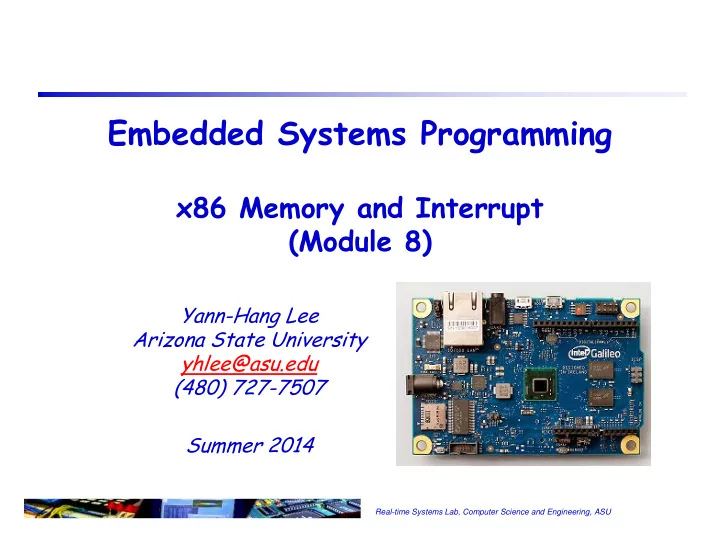

Embedded Systems Programming x86 Memory and Interrupt (Module 8) Yann-Hang Lee Arizona State University yhlee@asu.edu (480) 727-7507 Summer 2014 Real-time Systems Lab, Computer Science and Engineering, ASU
X86 ISA Data Representations Little-endian byte ordering in memory Words, doublewords, and quadwords do not need to be aligned in memory on natural boundaries. 2 memory accesses for an unaligned memory access aligned accesses require only one Unsigned integer, signed (two's complement) FP, string of bits, bytes, .. etc. SIMD packed data Pointer Near Far (logical) 1 Real-time Systems Lab, Computer Science and Engineering, ASU
Programmer’s model 2 Real-time Systems Lab, Computer Science and Engineering, ASU
Modes of Operation Protected mode (32 bits address) native mode (Windows, Linux), full features, separate memory virtual-8086 mode Real-address mode (20 bits address) the programming environment of the Intel 8086 processor with extensions native MS-DOS System management mode power management, system security, diagnostics IA-32e (Intel 64 architecture) Compatibility mode – similar to 32-bit protected mode 64-bit mode – 16 64-bit general purpose registers default address size is 64 bits and its default operand size is 32 bits. 3 Real-time Systems Lab, Computer Science and Engineering, ASU
Memory Model Flat memory model – a single, continuous linear address space of 2 32 bytes Segmented model – a logical address consisting of a segment selector and an offset Real-address mode – for 8086, 16 segments of 64K Linear address space (paging) physical space 4 Real-time Systems Lab, Computer Science and Engineering, ASU
Protected Mode Memory Management Use segment descriptor to protect memory accesses Each program has a descriptor table to map segments allow shared segments Memory access checks Limit, type, privilege level checks. Linear address space Restrictions of addressable domain, unused procedure entry-points, Logical addresses and instruction set. DRAM Local Descriptor Table SS ESP 0018 0000002A DS (index ) offset 0001A000 18 0010 000001B6 00002A00 10 00001A00 08 IP 00003000 00 00002CD3 0008 LDTR register 5 Real-time Systems Lab, Computer Science and Engineering, ASU
Virtual Memory and Paging Virtual memory uses disk as part of the memory, thus allowing sum of all programs can be larger than physical memory Only part of a program must be kept in memory, while the remaining parts are kept on disk. The memory used by the program is divided into small units called pages (4096-byte). OS maintains page directory and page tables Page translation: CPU converts the linear address into a physical address Page fault: occurs when a needed page is not in memory, and the CPU interrupts the program Virtual memory manager (VMM) – OS utility that manages the loading and unloading of pages 6 Real-time Systems Lab, Computer Science and Engineering, ASU
Page Translation A linear address is divided into a page directory field, page table field, and page frame offset. The CPU uses all three to calculate the physical address. 7 Real-time Systems Lab, Computer Science and Engineering, ASU
Interrupt and Exception Interrupt an asynchronous event that is typically triggered by an I/O device. Exception a synchronous event that is generated when the processor detects one or more predefined conditions while executing an instruction. three classes of exceptions: faults, traps, and aborts. 18 predefined interrupts and exceptions and 224 user defined interrupts Access handler procedures through entries in the interrupt descriptor table (IDT) A call to a handler procedure is similar to a procedure call to another protection level 8 Real-time Systems Lab, Computer Science and Engineering, ASU
Interrupt and Exception Interrupt vector references an interrupt gate (interrupt enable (IF) flag in the EFLAGS register is cleared) a trap gate Gate contains access rights information segment selector for the code segment of the handler procedure an offset into the code segment to entry point of the handler procedure 9 Real-time Systems Lab, Computer Science and Engineering, ASU
Recommend
More recommend